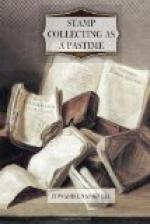But the most popular of all the philatelic publications are, of course, the monthly periodicals. The first stamp journal is said to have been The Monthly Intelligence, published at Manchester in 1862. It had but a short life of ten numbers out of the twelve required to complete Vol. I. But other journals followed in rapid succession, with more or less success, from year to year, till in 1893 a list of the various ventures in this line totalled up to nearly a couple of hundred. The Stamp Collectors’ Magazine, started in 1863, may be said to survive in Alfred Smith and Son’s Monthly Circular; The Philatelic Record, established in 1879, is now in its twenty-fourth yearly volume; Gibbons’ Monthly Journal is in its twelfth yearly volume; and The London Philatelist is in its eleventh yearly volume; and all may be said to be going strong. How many ordinary periodicals can boast of equally robust lives? And yet some people are still to be found who speak in all seriousness of stamp collecting as only a passing craze.
Properly speaking, tradesmen’s catalogues can scarcely be regarded as literature, and yet it would be very remiss on my part to close this chapter without a reference to the excellent catalogues with which stamp collectors are provided. What other hobby can boast of such comprehensive and detailed catalogues, giving the actual selling price of almost every item, and regularly revised and brought up to date from year to year? Messrs. Stanley Gibbons’ Priced Catalogue is comprised in four volumes:—Part I., The British Empire, 244 pages; Part II., Foreign Countries, 458 pages; Part III., Local Postage Stamps, 122 pages; Part IV., Envelopes, Post Cards, and Wrappers, 317 pages; in all, 1,141 closely printed double-column pages of small type, with thousands of illustrations. This excellent catalogue is at once guide, philosopher, and friend to the stamp collector. Some people irreverently style it “the Philatelist’s Bible.” It does not profess to be anything more or less than a mere catalogue of goods for sale, but it is an open secret that it represents the combined work and the combined knowledge of the best Philatelists of the day, and that neither trouble nor expense is spared to include within its pages everything that a collector needs to know to enable him to gather his treasures together, and to arrange them in the best possible and most authoritative order.
Much the same story might be told of the literature of stamp collecting in other countries. In the United States, in France, and in Germany there are numbers of robust periodicals, some stretching back into the early days, and there are scores of volumes of philatelic lore, many of which find a well-deserved place on the shelves of English collectors.
As an indication of the value attached to philatelic literature, I may mention the fact that an English collector recently paid over L2,000 for a by no means complete collection of works relating to stamp collecting.




